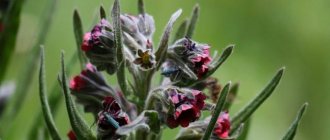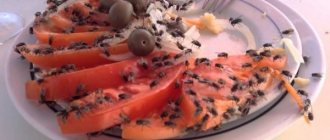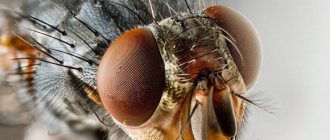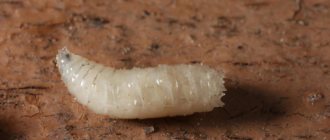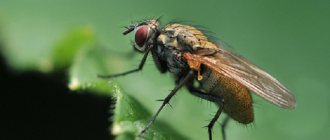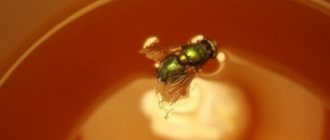Do all flies bite?
Ordinary house flies, so annoying with their constant buzzing and omnipresence since spring and throughout the summer, it turns out, are not at all to blame for the fact that, unknowingly for most people, they have been “caught” in increased aggression. Their absolute “alibi” is their physical inability to bite anyone. The proboscis of ordinary flies is too soft to pierce the skin of a person or animal, and is created by nature only to suck out juice, feed on liquid and soft food such as fibers of fruits or vegetables, rotting organic matter, etc.
The true “aggressors” are the autumn fly flies, which really bite in August and early autumn. It is because of them, outwardly so similar to their indoor counterparts, that the incorrect generalization began, claiming that by autumn all flies begin to “get angry” and attack.
Why is this happening?
People explain the paradox by the approaching period of hibernation and the imminent death of flying insects.
They are partly right - when the temperature drops below 10 degrees Celsius, flies significantly reduce their activity and fall asleep until spring. However, this circumstance is not associated with bites. Indoor household pests belonging to the species Musca domestica and permanently living indoors do not have a sufficiently developed oral apparatus that allows them to damage the integrity of the skin of people and domestic animals. They feed on liquid protein food or semi-solid organic matter, dissolving it with their saliva.
Other varieties of ectoparasites bite humans; they are externally and morphologically similar to their “brothers”, but feed on blood.
What flies can bite?
Firstly, it should be noted that not all flies are physically capable of biting. Many of them have a soft proboscis, which is simply incapable of piercing human skin, since its sole purpose is to allow the fly to feed on various semi-liquid substances, such as rotting products, fruit juice, and so on. But not all flies are so harmless. Closer to autumn, burner flies begin to appear, which are actually capable of biting through the skin, piercing it with their proboscis and drinking blood. They are very similar to ordinary flies, they are often confused, which is why a prejudice arises that spreads to the entire flying fraternity.
However, this insect exhibits some differences that are unique to the autumn fly. Thus, this fly is distinguished by the special position of its wings, which are longer than those of ordinary flies and are located wider, not adjacent to the sides. This insect has a speckled gray color, while ordinary flies are almost black. It is also worth paying attention to the proboscis of this insect - it looks like a sting and has a thickening.
Zhigalki can easily bite through the skin of animals, even cattle, so there are definitely no problems with biting a person. Unlike the same mosquitoes, in the case of mosquitoes, everyone bites, both females and males.
Housefly
An ordinary housefly is an insect that feeds on plant foods, protein waste, and biological components of human life. Habitats are most often associated with human habitation.
It does not bite humans or animals , since the structure of the oral cavity and soft proboscis allows the housefly to feed only on soft food, preferably at the stage of primary rotting and decomposition, and not bite.
The family has 2000 species. The most common are:
- Bazarnaya.
- Cheese.
- Drosophila.
Horseflies
Also one of the most biting types of flies are horseflies. They come in several colors: brown, yellow and gray. The size of their bodies reaches 3 cm.
These flies, as a rule, live near water bodies and swamps, since they cannot exist without moisture. The habitat of horseflies is located on almost all continents of planet Earth, with the exception of Antarctica, Greenland, and Iceland. These blood-sucking insects most often attack cattle and people. If in the first case, both males and females drink blood from live fly flies, then in horseflies, only females ; males prefer plant food.
The bite is so painful, that is, even people with normal skin type immediately experience itching, pain, burning and redness at the site of the bite. They say that there were cases when, after being attacked by a large number of horseflies at once, people ended up in intensive care due to lack of blood. Most likely this is fiction.
If we compare the amount of blood that a horsefly and a mosquito can drink, then one horsefly is capable of pumping into its body a volume of blood equal to the volume of 70 mosquitoes.
The horsefly, like other flies, is dangerous, not so much because it drinks blood from animals and people, but because during its bite it also throws out its saliva. Its saliva contains various toxic components, which cause skin irritation. But that’s not even the point, their saliva can also contain various bacteria that give rise to such terrible diseases as anthrax, polio and many others.
Therefore, it is recommended that in order to minimize the possibility of saliva penetration, it is necessary to apply pressure to the bite site; in case of redness or burning, it is necessary to apply a piece of ice.
Autumn zhigalka
The appearance of this fly for a non-specialist is no different from a housefly. The difference is determined by the structure of the digestive tract and the presence of hard oral plates. Zhigalki feed on blood ; it is this type of insect that so often poisons the first autumn days and is considered evil. Habitats are always adjacent to human habitation. Its second name is “village fly” , it is distributed throughout the world, with the exception of the polar zones.
The size of the burners is about 6-8 mm. After a bite, when a cut in the epidermis is made with a chitinous brush, the bloodsucker injects a toxic substance into the wound, so wounds after bites take a long time to heal, sometimes fester and constantly itch.
Biting insects
The familiar houseflies are not capable of biting because their mouthparts are not adapted to this. The proboscis of these dipterans is too soft to pierce human skin, and is designed to feed on the juice and pulp of fruits, as well as various rotting waste. Entirely different species bite, becoming more active in August-September.
Autumn burners
Their appearance will help determine which flies bite and which do not. Zhigalki (lat. Stomoxys calcitrans) are very similar to house flies, but their wings are spread out to the sides rather than located along the body. Dark stripes are visible on the back of these insects, by which a biting fly can be identified. At the tip of the proboscis there are bristles that can pierce the skin of a person or animal.
In the autumn, when you are in an area where there are a lot of insects, use protective equipment
The insect lives in pastures, in cattle pens or barns, where it can feed on the blood of animals. The zhigalka reproduces in manure and rotted hay. It feeds exclusively on blood in large volumes, which can exceed its own weight twice.
A fly bite causes burning pain. This is due to the fact that the burner not only roughly bites through the skin to the blood vessel, but also injects poison, which prevents the blood from clotting. It is this substance that causes a burning sensation , and as it spreads throughout the body it leads to irritation and itching. Sometimes an allergic reaction with fever and nausea is possible. Both males and females bite. The name “zhigalka” comes from the painful sensations during a bite.
The cycle from egg to adult is from 3 weeks to 2 months. During her life, the female manages to make 5-7 clutches of one hundred eggs. During the warm season, several generations of the zhigalka may appear, so by autumn the number of these bloodsuckers is growing rapidly.
For the development of larvae, the environmental temperature should not fall below +35°C, so the female chooses the warmest places in the hay and humus for laying, and sometimes lays eggs in the wounds of animals. If the ambient temperature drops to +10°C or below, the fly hibernates at any stage, be it egg, larva or adult.
Flies are capable of laying large numbers of eggs. High priority as a place is meat products
When it gets cooler outside, flies begin to look for warm shelter in the house, which is why flies bite in the fall. By this time, their numbers increase significantly. Having no other sources of food, they begin to attack people. Bites are especially dangerous for infants, the disabled and the elderly, as they are unable to ward off insects.
Other types of flies
Another type of biting flies is horseflies (lat. Tabanidae). It is larger in size than ordinary flies, its length can reach 3 cm. The abdomen of the insect is surrounded by yellow-red stripes, by which it is easy to identify. Lives near pastures and ponds. The name is due to the fact that when bitten, the horsefly becomes helpless, as if going blind.
They have a very painful bite for humans.
Only female horse flies feed on blood to reproduce. They can suck up to 200 mg of blood at a time. Males can be called vegetarians, because they eat exclusively plant nectar.
They live in large groups and are extremely fast.
Midges tend to attack in swarms , which causes pain, as well as an allergic reaction and severe swelling. These flies bite in August. Midges lay their eggs in bodies of water, near which you can see swarms of them. Only females feed on blood to procreate. Their proboscis is short, so they choose a place to bite where the skin is thin - open limbs, nose, eyelids.
The main target of gadflies is livestock. During their short life as adults, females lay eggs under the skin of their victims. When the larvae hatch, it causes suffering to the animal. Botflies rarely attack people, but if this does happen, a person may develop edema. Then you need to urgently seek help.
The most dangerous fly is the tsetse fly, which lives in Central Africa. She suffers from the so-called sleeping sickness, which affects tens of thousands of people every year. The disease is almost untreatable, and most of those infected die.
Not all flies attack people and animals. Will not bite:
- Green, or carrion, fly, with a very beautiful iridescence on the body. She is annoying, but does not pose a threat to humans.
- Hoverflies. In appearance they are very similar to wasps, they have transparent wings and yellow-black stripes on the abdomen.
This is interesting: how to get rid of flies at home
Causes of fly bites
Indeed, while it is summer and warm, bites of these insects are observed less frequently than with the onset of autumn. And there may be several reasons for this. Firstly, it is by autumn that the number of flies in nature reaches its maximum ; they manage to multiply significantly over the summer, because each female brings at least 400 eggs during its life cycle. Secondly, with the onset of cold weather, heat-loving insects actively rush into human housing, where they are warm and comfortable, and besides, they have the opportunity to bite people.
And it is also worth considering that as the weather gets colder, the need for protein increases in insects, which is necessary for survival at the moment, and also as a reserve for the winter, so that later, in the spring, after hibernation, they can hatch their offspring. So there is no question of any malice. Flies simply live their normal life cycle.
Why do flies bite in August and can flies “swarm”?
When do flies swarm?
Flies tend to swarm - annoyingly accompanying a person or animal in a whole cloud. But swarming in flies, as in other dipterans, is not a grouping of them - it is a random meeting of males and females for mating. In fact, a fly to a fly is a competitor. Each insect lives on its own and never joins its efforts in searching for food with other fellow tribesmen. On the contrary, they compete in finding a more advantageous place for breeding.
Why do flies bite in August?
It has been noticed that in August the flies become angry and terribly biting. They say that they simply feel the approach of autumn and drink blood for a safe winter.
This is a myth - house flies (Musca domestica) have not bitten throughout the summer season and are not going to do so (due to the structure of their digestive system).
And in August, the time comes for the mass emergence of flies of another species - the burner flies (Stomoxys calcitrans). The burner has a completely different structure of the mouth opening - while the housefly is capable of consuming only liquid food, the burner has a proboscis, which is equipped with chitinous teeth.
By friction of the proboscis, the fly chews the surface of the skin, feeds on blood and at the same time releases poisonous saliva into the wound, which causes burning and pain.
Burner flies bite - both males and females! It lays eggs in manure, compost heaps, and can even lay eggs in the wound of an animal or person.
Compare, in the first photo there is a house fly, next to it there is a live fly:
How to make a fly trap and sticky tape with your own hands, how to “draw” a picture using flies - read the article: “”
With the onset of spring, numerous insects become active. No exception are annoying flies that choose habitats closer to people. A lot of food, warm houses, excellent conditions for reproduction - this contributes to the growth of their population. But if in the summer annoying neighbors do not cause us much harm, in the fall everything changes dramatically. They actively annoy, attack and even bite humans.
There is an opinion that pests begin to actively attack humans only with the approach of cold weather. This phenomenon is associated with the rapid death of insects and their increased aggression. Of course, this opinion is wrong. So why are flies angry in August?
Common house fly
- is a vegetarian. As food, she chooses the juice of fruits and plants, the remains of human and animal vital activity, and rotting products. Having a soft proboscis, the fly is not able to pierce the skin, much less bite. She has no jaw and can only feast on liquid food.
Burner fly
- carnivorous pest. To maintain life, it must feed on the blood of animals and, less frequently, humans. Evolution has awarded them a dense proboscis, which is covered with chitinous plates. Such a “weapon” allows them to easily pierce the skin of not only humans, but also cattle. When bitten, the zhigalka injects a burning toxic poison into the wound, which is why its attack is so painful.
How to deal with autumn flies in the house?
The danger of fly bites should not be underestimated, especially if there are small children or disabled people in the house who are unable to ward off the pest. Take care to prevent the appearance of burners. It’s better in early autumn, close the entrance doors tightly, do not allow protein rotting products (old meat, fish, etc.) to appear in the house.
You can protect your premises using various flytraps
, which attract insects due to the presence of attractants. The “odorous” substance is placed in a small container and installed in places where flies most often appear - windows, entrance doors. Such traps can significantly reduce the population of flies in the house and “catch” individuals that accidentally entered.
An excellent solution would be the Fly Trap fly trap from Swissinno
(trap cost - from 500 rubles)
Another way to combat flies is to use sticky tapes that are hung from the ceiling or any surface. The pest sticks to the device and soon dies. True, such devices do not look aesthetically pleasing, and it is difficult to call them hygienic. As an option, you should turn to a modern solution - . The disadvantage of traps is that they are not able to destroy insect larvae and eggs.
preparations in the form of aerosols (sprays) or aquafumigators can be considered more powerful weapons against burner flies
Often such insecticides have a multicomponent formula of toxic poisons. As soon as the poison is sprayed onto the surface, chemicals begin to evaporate, which paralyze the internal organs of the fly. Insecticides in cylinders are very convenient to use.
It is enough to spray in places where pests accumulate, close the windows tightly and after a couple of hours there will not be a single fly in the room. The advantage of insecticides is that they kill not only various types of adult flies, but also destroy offspring and eggs that can be laid in hard-to-reach places.
This happens thanks to a dense cloud of insecticides that will penetrate into any crevice.
- processing area - up to 30 m2
- effective against - Flies / Ants / Mosquitoes / Cockroaches / Bedbugs
- cost - from 600 rubles
Read the instructions for use, reviews and
Are there too many flies in the house in the fall and no remedies help?
Try one of the most effective devices - insecticidal lamps. Special powerful units can very quickly clean the house of pests, without causing harm to the household. The principle of operation of the lamp is simple - they are equipped with a UV lamp, which emits heat and attracts the burner fly. Depending on the model, structures may be equipped with a special energized mesh. As soon as the fly flies up and lands on the grill, it will be struck by an electric shock.
In autumn, nettles sting more strongly, and flies become more angry and biting - many people note this in practice. And if everything turns out to be relatively clear with nettles, the plant cells simply begin to become woody after the plant blooms, then what happens to the flies? Many people, especially those who often travel outside the city in the autumn, would like to know the answer to this question.
If in the summer you can find quite a lot of flies, but they, for the most part, do not show aggression towards humans, then by the end of summer - by autumn they begin to bite strongly, and superstitious grandmothers point out that the insects sense the approaching cold weather, which adds to their aggression. However, one should not attribute emotions to them; insects are unlikely to have such intelligence.
Inhabitants of coastal regions
Horseflies are one of the varieties of flies that live mainly near water bodies and concentrations of cattle. Such a sonorous name for the species comes from the fact that during a bite the insect becomes defenseless, as if an invisible veil covers its eyes.
To begin with, these biting flies are very similar to mosquitoes. That is, only females drink blood, since it is needed to conceive offspring. As for the males, they are vegetarians and feed on plant nectar. Therefore, you only need to be wary of “girls”, who also have a very persistent character.
The appearance of a horsefly largely depends on its subspecies. Thus, the length of its body can vary from a few millimeters to two centimeters. For example, the bullfly grows up to 2.5 cm, which is why its bites are extremely painful. As for color, this species is easily recognized by the red-yellow horizontal stripes that encircle the insect’s abdomen.
Annoying burner fly
The more common name for this species is autumn zhigalka. This name is due to the fact that this insect moves into people’s houses only with the arrival of autumn cold weather. The reason for this behavior is quite simple: as soon as the temperature drops below 8 degrees, the fly will die. Therefore, she climbs into warm rooms in order to save herself from the coolness of the night.
Externally, the burner fly is very similar to its harmless relatives, only slightly larger in size. Thus, an adult has a body length of 5-7 mm. At the same time, the fly itself is gray: there are several dark spots on its belly, and four horizontal stripes of the same color run along its chest.
She bites because she needs blood. For her, this is an excellent source of energy, and it is also easily accessible. A razor-sharp proboscis helps her pierce flesh, which easily cuts through both human and animal epidermis.
Moreover, these biting flies inject a special enzyme into the wounds of their victims, which stops blood clotting. It is this that causes the intense burning sensation, which increases as the toxin spreads through the blood. In addition, such a solution can cause an allergic reaction, which can lead to high fever and nausea.
How does a bite occur?
The fly, as we have already said, has the necessary means of access to our blood.
Its proboscis has a pointed shape, and along the edges of its tip there are small teeth resembling a file. In this case, the tip of the proboscis looks flat, resembling a serrated knife. With the help of these teeth, the insect wipes the top layer of skin, after which it injects its poisonous saliva, the composition of which does not allow the blood to quickly clot, onto the bite site. Thus, having drilled a hole in the skin, this bloodsucker licks off the protruding blood droplets.
Gray fly
These dipterans can be up to 25 millimeters long. But these are very rare; ten-millimeter gray flies are more common. They are gray with black spots and have red eyes. They are often confused with ordinary flies. But this insect is much larger.
In addition, these dipterans immediately lay larvae. The nesting site is rotten fruit, carrion, feces, manure - any organic matter. For this reason, gray flies are called meat flies. No one would have thought that the gray blowfly was even useful in any way. These winged carriers of infection act as natural orderlies, destroying carrion.
This article is about black flies in the midge family. For other uses, see midge (disambiguation).
| black fly | |
| Simulium trifasciatum | |
| Scientific classification | |
| Kingdom: | |
| Type: | |
| Class: | |
| Order: | |
| Suborder: | |
| Infrasquad: | |
| superfamilies: | |
| Family: | midge Newman, 1834 |
| Subfamilies | |
Childbirth
Data related to Black Summer on Wikivid | |
The black fly (sometimes called the buffalo gnat, turkey gnat, or white socks) is any member of the family of midges in the infraorder Culicomorpha. They are related to midges, chironomids and Thaumaleidae. More than 2,200 species of black flies have been officially named, of which 15 have become extinct. They are divided into two subfamilies: Parasimuliinae contains only one genus and four species; Simuliinae contains everything else. More than 1,800 species belong to the genus Simulium.
Most black flies obtain food by feeding on the blood of mammals, including humans, although males feed primarily on nectar. They are usually small, black or gray, with short legs and antennae. They are a common nuisance to humans, and many American states have programs to suppress midge populations. They spread a number of diseases, including river blindness to Africa (Simulium damnosum and C. neavei) and South America (S. callidum and C. metallicum in Central America, C. ochraceum in Central and South America).
Why does swelling occur?
After the injection of saliva, a biting fly can fly away and forget about its action, but a person then experiences swelling after the midge bite. By the way, an allergy to midge bites is not the only manifestation. There are other risks associated with the possibility of blood contamination with viruses (the carriers of which these insects are), as well as with intoxication by microorganisms. The greatest activity of midges is observed during hot and sunny days, in August; most often they “attack” people wearing light-colored clothes. They often “hunt” at night. The smell of sweat also attracts them. In bad weather, such activity is not observed.
Tsetse fly
Central Africa is home to the most dangerous of all biting flies, the tsetse. Science knows that this insect is a carrier that affects about 10 thousand people a year. It should be noted that most of those infected die, since this disease is practically untreatable, especially in the later stages.
At the same time, she calmly tolerates the effects of the infectious agent. As for the reasons, this insect feeds on blood. At the same time, it doesn’t matter to him whether she is human or animal, the main thing is that there is plenty of her. Fortunately, modern medicine is getting closer and closer every year to creating a vaccine that can forever protect the human immune system from this deadly virus.
You have to endure the unpleasant proximity of flies, but when they start biting, it becomes unbearable. Why do flies bite in August?
Is there a risk from a bite?
The bite of such a fly is an extremely unpleasant phenomenon, as every person who is “lucky enough” to experience it will agree. The bite causes sharp pain, followed by a burning sensation. The fly does not use any painkillers; on the contrary, by piercing the skin, it injects a toxic substance that prevents the blood from clotting, which causes a burning sensation that only intensifies over time. The bite of such a fly is not at all a harmless phenomenon; it is a carrier of various diseases.
Pathogenic microorganisms can appear in her for a number of reasons - she bites animals that are not necessarily healthy, crawls on dirty surfaces, and during periods of starvation she can also feed on carrion if she does not have enough fresh blood. So its bite may well cause sepsis, allergies, tularemia, and even anthrax, such cases have happened.
Bite danger
The attack of a burner is an unforgettable moment for those who have never been lucky enough to become its victim at least once. Victims describe their sensations from the bite as a very painful prick followed by a strong burning sensation. The fact is that after cutting through the skin layer, the insect injects a special substance into the wound that prevents blood clotting. This substance is poisonous, and it is what causes that feeling of sharply increasing burning sensation.
But pain is not the only trouble that a burner bite brings with it. A fly is a fly, it lands on various dirty surfaces, bites animals that may not always be healthy, and in times of famine, even a fly does not disdain carrion due to a lack of fresh blood. All this carries with it a certain risk of contracting the following diseases:
- sepsis;
- tularemia;
- anthrax;
- allergies, etc.
An allergic reaction develops precisely to the poisonous secretion introduced by the burner fly after piercing the skin. In this case, the bite site may become very red, swollen and unbearably itchy (and this is only the mildest form of an allergic reaction to an insect bite).
If the allergy develops rapidly, in addition to the above symptoms, the victim may experience:
- severe swelling of the affected area;
- weakness, nausea with or without vomiting;
- dizziness;
- difficulty breathing;
- darkening of the eyes;
- Quincke's edema or anaphylactic shock - in the most severe cases.
If, with a mild allergic reaction, the victim can be helped independently (give an antihistamine, cold to the bite site, ointment for bites, etc.), then at the first suspicion of a more severe form, an urgent visit to a doctor is necessary.
How to protect your home
Many plants have a scent and secrete special enzymes that repel these insects. At your summer cottage, it is good to plant bushes of bird cherry, currant, and black elderberry under the windows ; these bushes will provide environmental protection to the house and flies will fly around it. Bouquets of the following herbs are also used :
- succession leaves;
- celandine;
- St. John's wort.
For apartments, the most suitable are geranium and tansy . By placing several pots with these plants on the windowsill, you can secure your apartment; bloodsuckers will not fly in and bite. In addition, geranium helps to significantly reduce the likelihood of mosquitoes, beetles, and ticks; these insects, which are also often annoying in the summer, cannot tolerate the smell of geranium.
An insect repeller can be installed in apartments; an ultrasonic device produces a low-frequency sound that is not audible to the human ear, but is well recognized by insects as a danger signal.
Keeping garbage cans, waste storage containers clean, and preventive treatment of cesspools in a summer cottage will ensure a significant reduction in the number of parasites, and as a result, the comfort of the home.
Information about flies
Experts count more than 120 thousand flies around the world. They can be found in any country. The most dangerous ones are found in warm climates. In the Russian Federation, the following biting varieties are common:
- Zhigalka. The life cycle of an insect is only 25 days. But there are cases when the zhigalka lives for 70 days. Body length no more than 8 mm. Its distinctive characteristic is the back with stripes. All other parameters resemble a house fly. If you look at it with special care, you can see that there is a chitinous tip on the proboscis. During the bite process, poisonous saliva gets under the skin.
- Horseflies are practically the largest flies that live on the European continent. They like areas where humidity levels are high. They bite cattle, which reduces milk yield. This type of winged species can carry leukemia and anthrax.
- An unusual species is the flywing. She has bulging eyes and an elongated body, the dimensions of which can range from 3 to 50 millimeters. They are considered a dangerous species and predators.
- The room type is quite common. They can carry parasitic diseases. After some bites, bacterial infections develop. The length of the proboscis is up to 1.5 mm. In this case, the mass of one individual does not exceed 12 mg. A female can produce up to 150 eggs during the breeding process. Over the course of her life, she makes approximately 4-6 clutches.
- Bloodsucker (deer). They are classified as ectoparasites, as they carry diseases of a similar nature. It rarely attacks humans. Due to the ability of this type to shed its wings, they are often confused with ticks.
- Black fly (April fly). Flights out during the flowering period of the common bird cherry. It is absolutely safe for human health.
- Carrion insects include the blue fly. It can produce 5 clutches during its life, which are made on corpses, meat waste or open wounds.
- The green type can cause parasitic diseases. Eggs are laid on open wounds or on corpses.
- Earth flies pose a danger to the crop. They can cause spoilage of cabbage, onions or carrots.
First aid
Multiple injuries are the most painful: if a fly bites the legs, arms, stomach and other parts of the body, inflammation develops. The bite causes soft tissues to swell and overall health may deteriorate. The wounds of the bitten person are treated with an antiseptic - brilliant green, alcohol, iodine.
In this case, non-alcoholic products will help - chlorhexidine, hydrogen peroxide. Also, when bitten, soothing and cooling ointments help, which reduces the manifestations of local reactions. To prevent fly bites from causing allergies in children, they give Zodak drops or Diazolin for children.
What to do if bitten by a fly?
You can quickly eliminate pain, redness, inflammation and itching using a variety of means. Scratching the wound is fraught with infection and other unpleasant complications. To treat a fly bite you must:
- Treat the affected area with hydrogen peroxide - you can use any disinfectant;
- Eliminate itching - special ointments, creams or gels will help with this;
- Taking an antihistamine is necessary to prevent allergic reactions in time.
The danger of a fly bite cannot be underestimated. If the affected area is very swollen or festering, with severe pain or a strong increase in temperature, you should consult a doctor. Timely diagnosis by a specialist will help determine or refute the presence of an infectious disease.
Fly bites are especially unpleasant in children. Kids lead active lifestyles and often neglect protective measures against insects (for example, staying away from landfills, garbage cans, or certain pets). Children's skin is very thin, so flies can bite even through clothing. The most important thing when detecting a bite in a child is to eliminate the itching. The baby can scratch the wound too much and cause an infection. Medical products intended for children will help cope with this problem.
You can protect yourself from insects using a number of effective measures. The simplest and most common are fumigators and mosquito nets. When planning a picnic in nature, do not forget about repellents. Special sprays or ointments for adults and children guarantee reliable protection against various insects.
A wide range of protective products against flies is available on our website. With us you can choose the ideal substance that will take care of your health.
How to prevent an attack?
There are several ways and methods to combat biting flies: this is a biological, chemical and mechanical method.
The biological control method involves the use of special insect predators. These predatory insects are absolutely harmless to humans and animals, but are dangerous for biting flies and their offspring, since predatory insects eat them.
The chemical control method involves the use of special chemical insecticides that can get rid of annoying flies. These preparations are used to treat animal stalls, manure heaps, farm premises, and so on.
And the last method of fighting flies is called mechanical .
This method involves the use of various mosquito nets, adhesive tapes, the use of various protective sprays against flies, as well as fly swatters.
How to get rid of burners
Despite the identified differences between flies and flies that do not attack people and animals, you can get rid of both species using the same methods. With a moderate number of insects, mechanical methods are quite suitable:
- Velcro tape;
- fly swatter;
- mesh on windows.
If there are too many flies, you can use more aggressive means - any insecticides against flying insects.
The autumn zhigalka fly is not a harmless dipteran, both in terms of transmitting infections on its legs and the relatively dangerous consequences of its bite. Therefore, active control of it is necessary to avoid infection with serious diseases.

